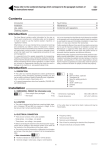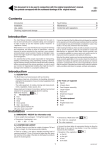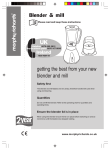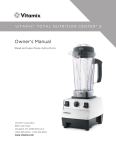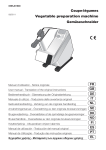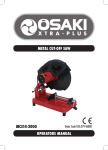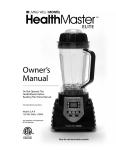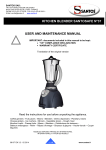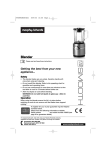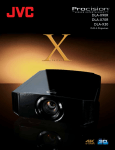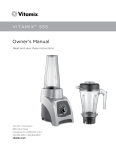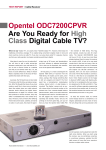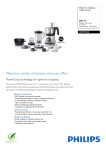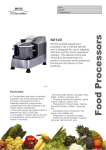Download Couverture K120 29474 DEAN.indd
Transcript
This document is to be used in conjunction with the original manufacturer’s manual. The symbols correspond with the numbered drawings of the original manual. GB 01/2007 Contents Introduction Installation Use, safety Cleaning and hygiene Fault finding Maintenance Conformity with regulation 1 1 2 4 5 6 7 Introduction The User Manual contains useful information for the user on how to work correctly and in complete safety, and is designed to make it easier to use the machine (called «machine» or «appliance» below). It is just as important that the Manual should always be available to the operator and it should be kept carefully where the machine is used ready for easy and immediate consultation in case of any doubt, or in any case, whenever the need arises. What follows is in no case intended to be a long list of warnings and constraints, but rather a series of instructions meant to improve the service provided by the machine in every respect, and particularly to avoid a series of injuries or damage to equipment that might result from inappropriate procedures for use and management. If after reading the Manual, there are still any doubts concerning how to use the machine, please do not hesitate to contact the Manufacturer or approved After Sales Service provider, who is constantly available to ensure quick and careful service for improved machine operation and optimum efficiency. Note that the safety, hygiene and environmental protection standards currently applicable in the country where the machine is installed must always be applied during all phases of machine operation. Consequently it is the user’s responsibility to ensure that the machine is operated and used solely under the optimum safety conditions laid down for people, animals and property. It is essential that all the people responsible for transporting, installing, commissioning, using, maintaining, repairing or dismantling the machine should consult this manual and read it carefully before proceeding with the various operations, in order to avoid any incorrect or inappropriate handling that might be result in damage to the machine or put people’s safety at risk. Introduction 1.1 DESCRIPTION 1.1 • These 11.5 and 17.5 litre capacity cutters are machines designed for cookery professionals for mincing, mixing, emulsifying, liquidising, kneading, etc. and can be used to process all types of foodstuffs (meat, vegetables, fruits, condiments, pastry, mayonnaise, etc.). A B C D E F G • For special preparations other than foodstuffs, PLEASE ASK US FOR DETAILS. Motor cover Removable funnel Removable lid arm assembly Transparent polycarbonate lid Stainless steel bowl Bowl locking knob Bowl locking clamps H Body I Fascia J Mains power switch (17.5l model only) K Stainless steel housing L Rubber feet Installation 2.1 DIMENSIONS - WEIGHT (for information only) - Dimensions of packaging: (L x l x h) mm: . 11,5l -17,5 modelx : 770 x 530 x 780 mm . Optional table: 750 x 600 x 200 - Overall dimensions (mm): 2.1 - Gross weight when packaged : 11,5/17,5: 83/92 kg - Net weight: 11,5/17,5: 58/68 kg 2.2 LOCATION • These machines are designed to be fitted onto a work top (table, base, etc.) of between 400 and 900 mm in height. The four feet ensure that it remains perfectly stable. • A stainless steel mobile table is available in option for the cutters. 2.1 2.3 ELECTRICAL CONNECTION 2.3a • Motor characteristics: A Motor code B Number of phases (3 three phase) C Nominal voltage in volts (value, range or commutation) D Frequency (Hertz) E Motor speed (rpm) F Nominal power (Watts) G Nominal current (Amperes) H Rating of fuse for protecting the electrical line (Amperes) I Indicative electrical consumption (kWh) • The 11,5 and 17,5 litre cutters are only available as standard in three phase, single voltage versions, with two speeds. The 11,5 litre model is also available in single phase supply with speed variation. • Check that the voltage of the electrical system is the same as that marked on the rating plate and the label on the power cable. • The machine must be protected by a differential circuit breaker and a fuse of the rating listed in column H of the characteristics table. 1 K120/180 GB 01 07 Note: The machine can only be used on TN (earthing to neutral) and TT (earthed neutral) type supplies. Where a machine has to be installed on an IT (impeding or isolated neutral) supply, there is a solution which consists of inserting an isolating transformer and locally putting on the machine on TN or TT supply. The machine must be earthed with the green and yellow No earth plug = no protection = risk of breakdown. Note: The earth values are defined according to the residual differential current (see NFC 15100 standard and PROMONTELEC guide) and must be checked by an electrician. Damage caused by inadequate earthing is not covered by the guarantee. a) Three phase, single voltage 2 speed motor • A 3 pin + earth standardised wall socket with a 20 A fuse is required, as well as a matching watertight plug for the power cable. The machine must be earthed with the green and yellow wire. In certain circumstances depending on the sensitivity of the protective cut-outs, it may be necessary to install SI-type (super immunity) devices to prevent untimely triggering. • Check the direction of rotation of the rotor at both speeds: - Turn the mains power switch (depending on model) in a clockwise direction to the I position. - Turn the knob G to the I low speed position (see § 3.1). - Check the direction in which the rotor is turning through the transparent lid (anti-clockwise - as per the arrow marked on the rotor handle). - If it is turning in the wrong direction, change over the two phase wires of the plug. To PAT test the Electrolux Range of Food Preparation Equipment, the PCB board needs to be disconnected before any test is done. This is due to the fact that the boards are fitted with a grounding diode that can give incorrect result during such a test. Also on a standard appliance a flash test of 25 amps and up to 3000v is used but, as you would expect, to use this on equipment, which has a printed circuit, board would be quite destructive to that board. We would recommend the use of a PAT tester approved for computer systems which use a lower rate of amps. b) Three phase, single voltage one speed motor with frequency variator • The cutter is supplied with a single phase current up to its variator, which transforms the current to supply the three phase motor. • A 2 pin + earth standardised wall socket with a 20 A fuse is required, that is easily accessible. • Check that the mains voltage matches that on the rating plate of the machine and the power supply cable. • Warning to the installer: This cutter with electronic speed variation is equipped with a filter built into the variator which earths any system interference without passing through the variator. In order to be effective, the installation must have a good quality earth, otherwise the interference could pass through the variator and damage it. The appliance is perfectly safe and is CE certificated. There are two ways to get overcome this problem. · Disconnect the board as instructed and test using test for PC’s, · Or install the mixer on a fused spur (no plug) as this takes it away from being a portable appliance and the PAT test is then not needed. Use, safety - 3.1 OPERATION - SAFETY • - User safety is ensured by: User safety is ensured by the following features: The motor stops when the lid is unlocked The bowl and lid must be locked before the appliance can start After a stop, the «start» button must be operated («no voltage» feature) The motor is halted by a brake before the rotor can be accessed Continuous action operation to control the progress of the preparation. Automatic locking in place of the rotor during rotation, linked to the blade angle The standardised size of the lid spout allows products to be added in mid-cycle. The design of the bowl (leak prevention tube). The bowl, lid and rotor are easy to dismantle for cleaning. a) Continuous operation: I –II - Select ------ on E by pressing and holding button A. - Start by pressing button D or button I. - Stop by pressing button C. Always start in low speed then change to a higher speed once the texture of the product changes. b) Pulse operation: - Press button J c) Change speed: - Select speed H by pressing F or G - Control panel 3.1 A,B,E: timer C : stop button D : start button F : increased speed button G: lower speed button H : speed indication lamp I : high speed position II J : pulse operation button F-G : variable speed model K120/180 GB 01 07 The cutters can be started if: the lid is correctly locked onto its 4 clamps the lid has been lowered and locked. the mains power switch (K 180 model) is in the start position d) Stop: - Press button C. Preferably use button C then unlock the lid. - If the machine is stopped for several days, unplug it to switch off the power supply to the variator 2 3.2 VARIOUS EQUIPMENT: • As standard, the cutters have a rotor with two very hard, angled plain stainless steel blades (A), which may be used for the following types of work: - Mincing of meats and chopping of parsley, garlic, onions, etc. - Preparation of butters, mayonnaise, purées, etc. 3.2a - Kneading of all types of doughs/pastries. • A rotor with toothed blades (B) is available for liquidising shellfish and fish and grinding breadcrumbs, almonds, etc. (please ask for details) 3.2a 3.2b-c A Lower inclined perforated knife B Upper inclined perforated knife C Middle flat perforated knife D Handle E 15 mm spacer F 30 mm spacer G Spacer with shoulder • Rotors without cut-outs are available on request, for certain tasks using meat. (speed 1500rpm). 3.3 USE OF THE CUTTERS • The cutters are supplied with the bowl and the lid fitted and the rotor inside. Before using the cutters, always check the cleanliness of the bowl, the lid, the rotor and the drive shaft. • To unlock the lid: 3.3a 1) Raise the locking knob. 2) The locking pin of the bowl drops into the notch in the knob. The machine stops if the user forgets to press the STOP button. 3) Press the top of the arm to remove the pin from the notch and open the lid to the rear stop. 3.3b • To unlock the bowl: • To remove the lid from the arm: 3.3d 1) Turn the funnel in an anti-clockwise direction that the key is aligned with the lid cavity. to its stop, so 2) Remove the funnel and tilt the arm backwards to the stop. 3.3e • To remove the arm assembly from the cutter lid: 3.3f 1) Position the lid vertically so that the two pins of the pivot spindle are aligned with the cut-out in the bushes. 2) Pull the arm vertically to remove it. • To fit the bowl, lid, arm and funnel, proceed in reverse order. 3.3c 1) Hold the bowl by its two handles and turn it in a clockwise direction to release it. 2) Lift it vertically and the rotor will be released automatically. The rotor may also be removed separately. 3.4 USE OF THE EQUIPMENT - The angle of the blades and the setting of the distance between them ensure a rapid and consistent mix. • Always begin in speed I before changing to speed II. • Use speed I in PULSE mode to start or finish any work which requires attention or precise finishing (see §3.1b). Never insert your hand or a hard object in the bowl when the machine is in operation. Note: Liquids or ingredients may be introduced by the lid funnel whilst processing is taking place. - The height of the central tube of the bowl ensures that liquids will not leak. ALWAYS install the rotor after positioning the bowl 3 K120/180 GB 01 07 3.5 SOME POSSIBLE APPLICATIONS The quantities are given for information purposes only. • Types of blades plain A toothed B REMARKS PRODUCTS MEATS A All types of stuffing and mousses. Rough mincing - Terrines - Sausages - Beef burgers - Min./max. quantities Cut the meat into pieces and remove bones and nerves. Speed I continuous or pulse mode. Short duration (10 to 30 seconds, depending upon the thickness desired. 200g/5 kg (11,5 l bowl) - 500g/8 kg (17,5 l bowl) Fine mincing Speed I until rough mincing is completed then speed II. Longer duration (1 to 4 minutes) Ensure that the blades are kept sharp. - Stuffing - Mousses REMARKS KNEADING B DOUGH/PASTRY Speed I continuous mode, and place all of the ingredients in the bowl:flour, salt, butter and water. It only takes a few seconds to prepare the pastry (10 - 15 s) The water used must be cold in order to prevent the pastry from becoming too hot. For cold water paste, with the maximum quantity, the water must be added to the flour and mixed immediately. - Shortcrust - Shortbread - Cold water paste - Puff - Quiche 500 g/4 kg of flour (11.5 l bowl) - Min. / Max.quanti- 500g/6 kg of flour (17.5 l bowl) ties - Min./max. quantities 200g/3 kg (11,5 l bowl) 500g/5kg (17,5 l bowl) FRUITS AND VEGETABLES A PRODUCTS A Speed I only. For the purée, pour in the hot, drained vegetables then add the fat. Turn to speed I then add the boiling liquid (water, milk, stock, etc.) VARIOUS The bowl and the ingredients must be at room temperature. - Mayonnaise At speed I PULSE mode to mix eggs, mustard, salt and pepper. - Purées - Mousses - Stewed fruits - Coulis, sorbets - Min./max. quantities 200g/5 kg (11,5 l bowl) 500g/8 kg (17,5 l bowl) CHOPPING VEGETABLES A - Parsley - Onion - Max. quantities POWDER B - Almonds - Hazelnuts - Breadcrumbs - Shellfish, poultry - Max. quantities Change to speed I continuous mode, and gradually pour the oil in until completely emulsified. For small quantities, cover the bottom of the bowl with oil and increase the quantity of mustard. The parsley must be dried thoroughly. Speed I continuous mode then II speed for fine chopping. Use very sharp blades. Avoid using large, juicy onions. Speed II PULSE mode. Fill the bowl Start in speed I then switch to speed II to obtain the desired smoothness. For mixtures of equal amounts with crystallised sugar, reduce the sugar using speed II then add the almonds or hazelnuts. 3 kg(11.5 l bowl)/ depending upon the 5 kg (17.5 l bowl) volume of the product. - Max. quantities } 3 eggs / 6 litres of oil (11.5 l bowl). 5 eggs / 8 litres of oil (17.5 l bowl). - Butter sauce for snails Speed continuous mode II for parsley, garlic, shallots, then add the butter (avoid using cold butter). Then use speed I pulse or continuous mode to mix it all together. - Max. quantities 3 kg (11.5 l bowl) 5 kg (17.5 l bowl) } of butter Cleaning and hygiene 4.1 IN BETWEEN USE • Remove the bowl, the lid and the rotor (see §3.3). Note: - Use cleaning products that are compatible with the plastic • Using running water or a bowl of water to clean these parts, (polycarbonate), stainless steel and aluminium (no chlorinated use hot water as well as a detergent - degreaser - disinfectant products) parts. (if working with greasy products). - Do not use abrasive products to clean the transparent lid. • Check that the parts have been cleaned properly. Handle the rotor carefully (risk of cuts, impacts, etc.). • We strongly recommend sterilising the rotor periodically. K120/180 GB 01 07 4 4.2 AFTER USE • Unplug the machine. - The bowl and the rotor may be cleaned in a dishwasher if the • To remove and clean the rotor, lid and bowl, see §3.3 and blades are protected against impacts. 4.1. Do not wash the machine with a pressure cleaner. • If necessary, clean the outside of the machine with a damp sponge and a detergent - disinfectant, paying particular attention - In order to avoid acid stains on the rotor blades, we recommend to the rotor drive shaft and the bowl support, then rinse. that they be dried thoroughly before putting them away, and to keep the rotor in a cold room to limit the development of germs. Note: - Use cleaning products that are compatible with the materials - Do not leave the lid on the bowl when the machine is not being used. Keeping it in the open will get rid of condensation and the of the machine. - The drive shaft and the inside of the rotor must be kept per- concentration of lingering odours. fectly clean Fault finding 5.1 THE MACHINE WILL NOT START, CHECK THAT: Note: The first fault detected is stored in the memory. When the power supply to the variator is switched off, the fault is erased. Look for the cause of the fault before resetting and switching the power back on. • The machine is plugged in. • The electrical power supply to the socket is correct. • The lid and bowl are correctly locked (see §3.3). • If the cutter stops in mid cycle: - The thermal probe of the motor has been triggered. Wait for a few minutes before starting up again. - Reduce the quantity of product being processed. - Check the mechanical transmission of the machine. • For the electronic speed variation models: - Check that the variator is operating correctly by removing the top cover and the housing. - If the red LED is lit, call in a specialist. - If the green LED is lit, the variator is operating correctly. - Unplug the machine and check the electrical circuit (see § 6.3) Respect the safety instructions for dangerous voltages (see § 5.2). 5.2 ABNORMAL NOISES OR OPERATION Stop the machine. • Metallic noise - Rotor is rubbing against the bottom of the bowl or is loose. - Foreign body in the bowl. • Grating noise - Defective belt (see §6.1 for replacement and tensioning instructions) • Motor noisy: - Motor operating on two phases. Check the connection and electrical circuit (see electrical wiring diagram §6.3). • Lack of power of the variator (model with speed variation) - The electronic variator can limit the power automatically and set itself at a speed lower than that displayed on the potentiometer knob when: .The speed selected is too high (risk of the belt slipping and wearing). . There is too much product in the bowl. - Proceed as follows, depending on the cause: . Reduce the speed displayed (see §3.3). . Reduce the quantity of product (see §3.6). • No speed variation: - Faulty potentiometer. - Potentiometer wires broken or cut. • If the direction of rotation is incorrect: - The machine must be unplugged. - Remove the top cover and the housing. Wait for approximately 1 minute until the capacitors have discharged before touching the inside of the machine. DANGEROUS VOLTAGE - Check that the green LED of the variator is extinguished and remove the plastic cover plate. - Change over the wires on the U and V terminals. An insulated screwdriver must be used for this operation. - Fit the plate, housing and cover. - Plug in the machine and check the direction of rotation. - Ne pas s’inquiéter du léger bruit de ventilateur lorsque la machine est sous tension, il s’agit d’une caractéristique normale de fonctionnement. 5.3 WORK QUALITY • To obtain perfect and rapid results without overheating: - always use sharp, undamaged blades, change them if they have had impacts, - use another rotor exclusively for delicate work (e.g. chopping of parsley). 5 - avoid using excessive quantities of products, which may cause overheating (meat, pastry). Note: if necessary, redress the edge of the blades on the opposite side to where they have been sharpened, using a grindstone. K120/180 GB 01 07 Maintenance 6.1 MECHANICAL PARTS • These cutters only require a minimum amount of maintenance (the motor and the mechanical part bearings are greased for life). • It is recommended to check the following at least once a year: - The tension and wear of the belt. - The condition of the electrical connections. - Tension the belt by tightening B with a large screwdriver. - Tighten the 4 motor attachment screws solidly. - Check that the tension is correct by pinching it between thumb and index finger. The difference between the two sides of the belt should not exceed 15 mm in total. - Refit the various parts. Note: It is absolutely essential to tension the belt correctly. Insufficient or excessive tension will causes transmission problems and even premature wear of the belt or bearings. • To tension or change the belt: - Unplug the machine. - Remove the lid and arm in order to separate them from the top cover and remove the bowl (see §3.3). - Remove the top cover (four screws) and disconnect the wiring harness (unclip the mains switch for the 17.5 l model). - Remove the stainless steel housing. - Loosen the four motor attachment screws A by two turns (6 mm Allen key). - Unscrew the tensioning screw B. - If the belt is to be changed, lie the machine on its side and remove the base plate (four feet and three screws). - Check that the teeth of the belt mesh correctly with the pulley grooves. • Access to electrical components. - Unplug the machine. - Remove the top cover (4 screws) and disconnect the wiring harness if necessary. Residual voltage at the capacitor terminals. • The capacitors may retain an electrical charge. To avoid taking any risks when carrying out work, we recommend discharging them by connecting their terminals with an insulated conductor (e.g. a screwdriver). 6.2 ADJUSTMENT OF THE SAFETY DEVICES • Check that the safety devices are operating correctly on a regular basis. When the lid is opened, the motor should be stopped by braking and should not start if the bowl or lid are missing. • If this does not work: - do not use the machine. - have it adjusted by the service department of your local dealer. 6.3 ELECTRICAL COMPONENTS 6.3 See electrical diagrams at back of manual • - • Identification of the components (2 speed and variable speed machines) S1: Lid safety device S2 : Bowl safety device M : Motor CC : Control card Cpu : Power supply card CF : braking capacitor Q1: Main switch (model K180) V: Variator Identification of the colours of the wires: Power circuit: black (F) Control circuit: red (A) Phases: L1 - L2 - L3 (three phase) Neutral: N Earth: B/C yellow and green 6.4 ADDRESS FOR SERVICE REQUIREMENTS We advise you to contact the dealer who sold you the machine. For any information or orders for spare parts, specify the type of machine, its serial number and the electrical characteristics. Dealer’s stamp • The manufacturer reserves the right to modify and make improvements to the products without giving prior warning. Date of purchase :................................. K120/180 GB 01 07 6 Conformity with regulations The machine has been designed and manufactured in conformity with: - Machine directive 98/37 EEC - The CEM directive 2004/108EEC - 2006/95/EEC: Low Voltage Directive - 2002/95/EC: Equipment recycling directive 2002/96/CEE « WEEE » The symbol « » on the product indicates that this product may not be treated as household waste. Instead it shall be handed over to the applicable collection point for the recycling of electrical and electronic equipment. By ensuring this product is disposed of correctly, you will help prevent potential negative consequences for the environment and human health, which could otherwise be caused by inappropriate waste handling of this product. For more detailed information about recycling of this product, please contact the sales agent or dealer for your product, your after-sales service, or the appropriate waste disposal service. 2006/12/CEE“Waste” The machine is designed so that it does not contribute, or as little as possible, to increasing the quantity or harmfulness of the waste and the risks of pollution. Make sure to observe the recycling conditions. 94/62/CEE“Packaging and packaging waste” The packaging for the machine is designed so that it does not contribute, or as little as possible to increasing the quantity or harmfulness of the waste and the risks of pollution. Make sure to eliminate the various parts of the packaging in appropriate recycling centres. - To the European standards: EN 12852 - Culinary preparations. safety and hygiene related presentations. This conformity is certified by: - The CE conformity mark, attached to the machine - The corresponding CE declaration of conformity, associated with the warranty. - This instruction manual, which must be given to the operator. Acoustic characteristics: - The acoustic pressure level measured in conformity with the EN ISO 3743.1-EN SIO 3744. Protection indices as per the EN 60529-2000 standard: - IP55 electrical controls - IP34 overall machine Electromagnetic compatibility in compliance with the following standards: - EN 55014-1: Emission. - EN 55014-2: Immunity. Integrated safety - The machine has been designed and manufactured in compliance with the relevant standards and regulations, mentioned above. - Before using the machine, the operator must be trained to use the machine and informed of any possible residual risks . Food hygiene: The machine is made from materials that conform to the following regulations and standards: - Directive 1935/2005/CEE: Materials and objects in contact with foodstuffs. - Standard EN 601-2004: cast aluminium alloy objects in contact with foodstuffs. The surfaces of the food area are smooth and easy to clean. Use detergents that are approved for food hygiene and respect the instructions for their use. The machine has been CNERPAC approved for food hygiene as well as being granted the Certificate of Sanitary Conformity by the Sanitary Research and Engineering Department. 7 K120/180 GB 01 07








